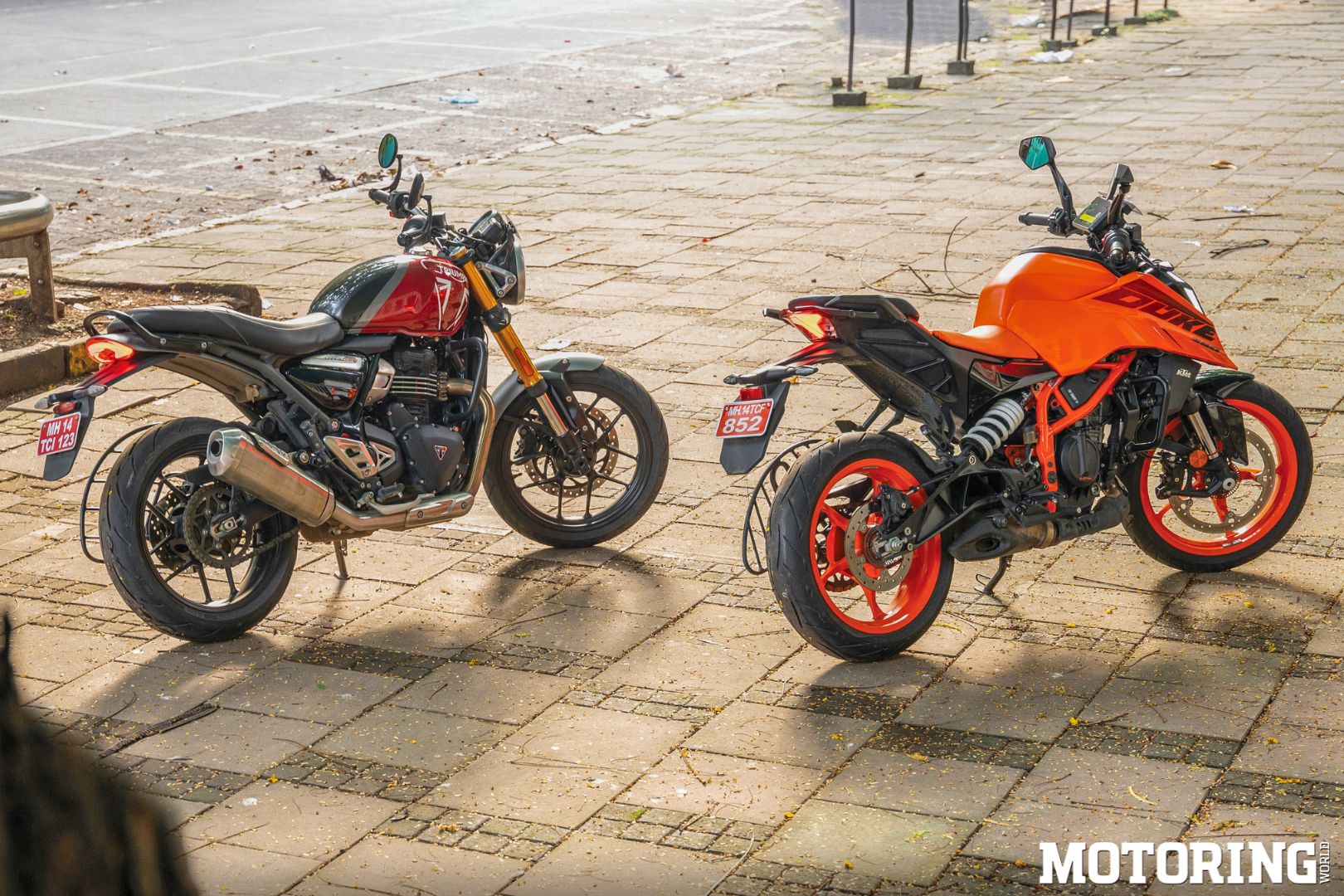Now, 70 kph is not an eye-watering velocity for a 400cc single. However, it turns out that there are different ways of staying at that speed. It can be done in second gear, enveloped in a storm of sensations. Or it can be in fourth gear, with more dignity than the previous approach. That’s basically the difference between the KTM 390 Duke and the Triumph Speed 400. They’re 400cc singles built for Austrian and British brands by Bajaj, both are designed with platform sharing in mind, but they are as different as the proverbial writing stick and the dairy product.
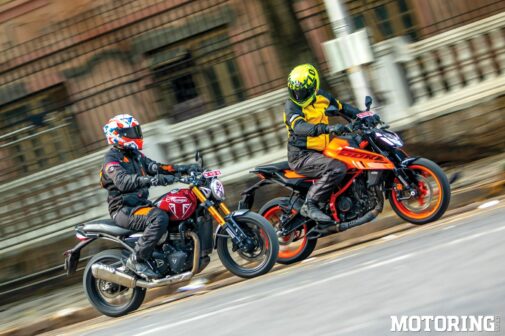
Heck, they even feature components such as the chain sprocket assembly and brakes on opposite sides, eager to underscore their divergence, lest people claim they’re built from the same parts. They’re not, of course. The Duke has Mattighofen’s trademark trellis frame wrapped around the new LC4c engine, along with a beautiful rear subframe that’s just begging to be painted in a brighter colour. The Speed has Hinckley’s modern-retro lines formed around that equally new TR Series engine that shows off historic shapes topped off by lovely machined cooling fins. However, even though the Duke’s finish has
improved by miles, the Speed still feels more premium next to the KTM.
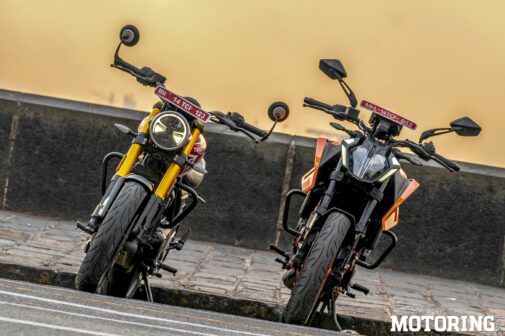
However, the compact Duke chooses purpose in both forms and function, while the Speed is far more easygoing and approachable. I believe both of these motorcycles are consummate urban machines that are up for sporadic forays onto highways, which is down to their one-hour seats more than anything else. And both could establish permanent residences in the twisties, too. However, if two riders went down a canyon road on these two bikes and met at the bottom to compare notes, each would doubt if the other had ridden on the same road. Again, that’s how contrasting these motorcycles turned out to be.
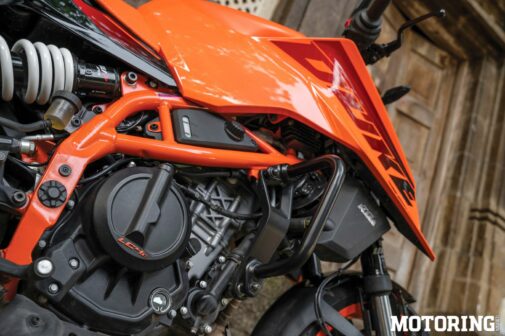
The Duke wanted to throttle and brake everything and everywhere, behaving very much like an orange blizzard. At first, its sporty riding position ensured that I kept thinking, ‘What’s that?’ only to realise it was the front wheel in my peripheral vision. I don’t remember the last time that happened to me on a bike, and it left me feeling as if I was windborne. With 45.37 bhp turning the world ahead into a high-speed tunnel-vision event, it was easy to imagine the Duke leaving everything behind in a high-rpm vortex. And I was always two gears lower than usual around town to maximise the frenzy that the Duke revels in.
Also, this particular Duke came with one example of a cosmic fluke — a quick-shifter that worked! I now have a theory — KTM/Bajaj calibrates the shift sensor for loads generated by street/ normal boots, not for handling the thicknesses and pressures of proper riding boots. With street boots, the quick-shifter worked flawlessly, issuing staccato pops with every shift, which was a pleasant addition to the Duke’s collection of sensory revelations.
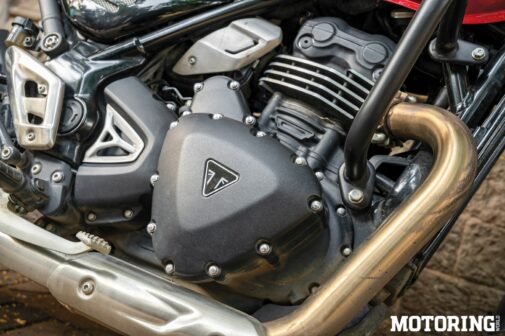
The Speed, meanwhile, was never really far away, though it preferred more of a rapid flow along the road with its 39.5 bhp than the Duke’s intense behaviour. It was far roomier than the Duke, too, and tolerant of a wider range of riding states of mind. I could rev it out in each gear or hold a higher gear at low rpm, and it simply went along with either. It was louder than the Duke, too, and in a good way. The Speed’s booming resonance was a great reason to keep working the throttle and let that well-finished exhaust sing its deep songs. That’s even more so when it comes to corners, of course.
The KTM’s nose searched for apexes like a sniffer dog, and even a whiff of a bend was enough for the never ending chase to begin. The highlight of the Duke’s constant hunt for corners was its ferocious precision, tip-toeing on imaginary racing lines at fun speeds, playing a counterfeit Brad Binder. On the Speed, with the right attire, I could one day hope to play a counterfeit hipster. Knee downs while wearing jeans and a flannel shirt? Why not, I say. And while the Triumph lacked the Duke’s laser-like precision, it still had enough agility to go where it was pointed at a moment’s notice. As for the brakes, the Duke’s stonking units had the clear advantage over the Speed’s softer ones, quite in line with the former’s clearly stated intentions.
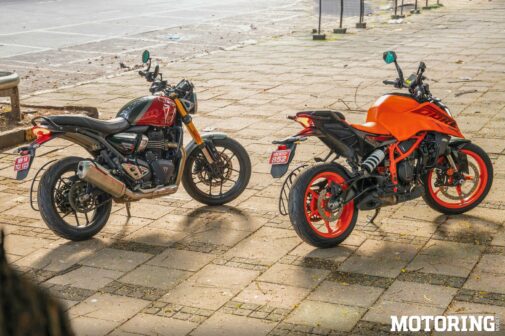
I played around with the Duke’s adjustable suspension and found that the third of the five clicks worked best for me. Ironic — the factory setting is the best on a bike that finally offers some tweaking. However, it will allow the Duke to accommodate a wider range of rider weights and preferences, much like the rest of the bike’s newfound affability. On one occasion, I tried to wheelie the Duke,
but it was erratic. Later, I was told that the launch control in Track mode must’ve thought I was asking it to report for duty, and that Street mode was better for one-wheeled action. Gah. Anyway, getting onto the Speed 400 after days of riding the Duke felt like I was on a cruiser. And one that wheelied high in second gear, even catching its traction control napping before it awoke in a hurry and brought the front wheel down to reality.
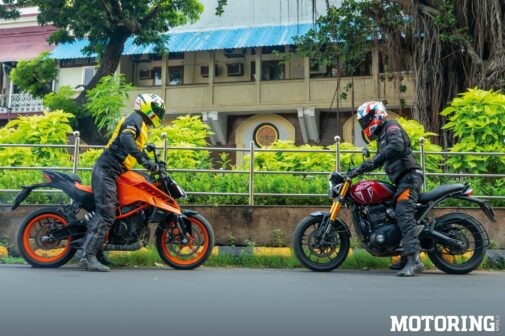
The Duke’s launch control was…interesting. I suppose it will work well for riders who want to sound loud and talented while taking off from a traffic signal without wetting their pants. They will get a total of three chances to use the system, and then will have to wait for 20 minutes for the clutch to cool down before they can get back to pretending that they know what they’re doing. It goes without saying that the most fun way to launch the Duke is to turn everything off. Also, a lap timer on a street bike? Not required, really, and the Duke will reach everywhere first anyway.
As I mentioned before, both seats are good for about an hour each and that confines them mostly to city limits. Though adventurous backsides could go looking for horizons to chase anyway. Also, the tyres on the Duke are good for exploring perhaps 70 per cent of the Duke’s ability — but is that what the Duke is for? And these Metzelers are lower-rated versions of the ones that arrived on the first-gen Duke ten years ago.
Oh, come on already! On one occasion, I braked really hard at high speed and had the rear wheel slide for a good distance despite the presence of ABS and a slipper clutch. The Triumph just about made do with its own tyres, but that’s clearly not a glowing compliment of any kind. The bottom line was clear to me — both motorcycles could do so much more with better tyres.
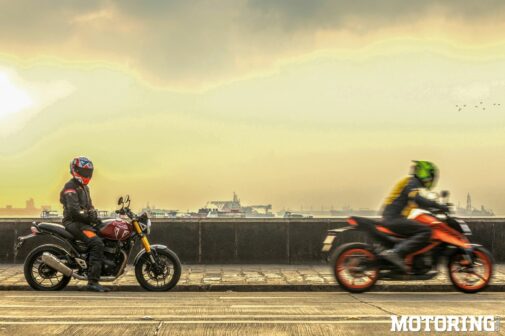
Moving on, the Duke has enough orange on it to embarrass a year’s worth of sunrises and sunsets, and it got me thinking if the Speed should’ve had its wheels in the same colour as its tank. Also, the KTM appeared far more alien against South Bombay’s dignified old shapes, while the Triumph blended right in. I liked the fact that I could simply turn its key and ride the Speed without having to fiddle around with the modes and settings and whatnot. The KTM, on the other hand, packed a lot of technology for its price, all of it aimed squarely at going fast. And it won’t take a genius to figure out that the Speed 400 may have the name, but it’s the Duke who owns the idea.





